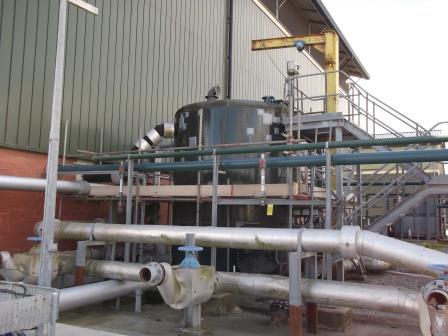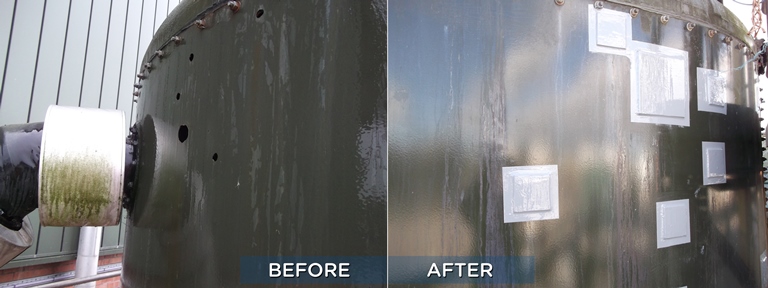Water treatment tanks are highly susceptible to corrosion due to handling aggressive chemicals on a daily basis. In the presence of moisture at the vapor interface, the biological conversion of hydrogen sulphide gas to sulphuric acid can take place.
Hydrogen sulphide gas can directly attack metals such as copper, iron, and steel. Corrosion in turn leads to metal losses where through-wall defects can develop. And that’s exactly what happened this past September at a sludge buffer tank at a Wessex Water sewage treatment site. The tank, which had been fabricated from glass fused to steel (GFS), was suffering from through-wall corrosion at the vapor interface level. The client had only been able to run the buffer tank at a reduced capacity of 65 percent. It was a big problem that needed a quick solution!
Process Problems
Wessex Water is a regional water and sewage treatment business serving an area in southwest England, covering

3,861 square miles (10,000 km²), including Dorset, Somerset, Bristol, most of Wiltshire, and parts of Gloucestershire and Hampshire. The treatment site deals with various types of domestic and industrial effluent, which is treated at the sewage treatment works before being safely returned to the environment.
Wessex Water had been using anaerobic digestion to process sewage sludge at larger sewage treatment works since the early 1960s. The bacteria in the tanks breaks down the organic material in sludge, which produces a mix of methane, carbon dioxide, and hydrogen sulphide gases.
After carefully assessing repair alternatives for the sludge buffer tank, Wessex Water selected Belzona cold plate bonding technology. This solution kept the site running with minimal disruption and was completed without hot work or the use of mechanical equipment. Additionally, these epoxies are easily applied on-line to wet and oily surfaces where only minimal surface preparation is required. Now all they had to do was get to work!
Spark-Free Environment
The repair was carried out by Belzona Technosol’s two-man team. The crew, which is from Belzona’s application division, worked to install the prefabricated steel plates to cover the leak areas. The plates were manufactured into 100-mm-by-100-mm-by-5-mm (4" x 4" x 0.2") and 200-mm-by-200-mm-by-5-mm (8" x 8" x 0.2") sizes. After general cleaning to remove some contaminants, they used hand tools and emery paper to prepare the surface to ensure good mechanical adhesion and also to mitigate another issue: H2S levels.
Because the tank was still in service (though operating at a low level), the crew needed a safe permit to work, which meant gas tests and isolations. Also a full Risk Assessment and Method Statement was made prior to application to cover any safety issues. “Due to the H2S levels present in the tanks, we could only carry out surface preparation utilizing hand tools and emery paper,” explained Marc Lewis, team leader. Anything else would have risked causing sparks.
Wearing helmets, safety boots, gloves, eye protection, and safety harnesses, they started the external repair by “first removing sludge by scraper and rags. [We] marked out areas for repair and prepared by wire brush, and then used emery paper for roughening in all directions,” as Lewis said.
The crew blasted the steel repair plates to a surface cleanliness of International Organization for Standardization (ISO) standard 8501-1: Sa 2½ for very thorough blast-cleaning. This provided a surface profile of a minimum of 3 mils (75µm). Repair plates were pre-coated with Belzona 5831 (ST-Barrier) and allowed to solidify for 24 hours. Once cured, the plates and the repair areas — about 30 in total — were wetted out using Belzona 1831 (Super UW-Metal) to ensure full contact and excellent adhesion. A layer of Belzona 1831 was then brush-applied over the repair areas. The plates were lowered and pressure-applied to allow the material to exude from the sides, which confirmed full contact between the tank surface and the bonded plate and guarantees a long-term repair. The crew then cleared away any excess material and brush-applied a coat of Belzona 5831 to the external side of the plates to prevent future corrosion. They checked coating thickness with wet film thickness (WFT) gauges and visually inspected the tank before calling it a job well done.
Sludge Contained!
For Wessex Water, this solution was perfect for their specialized needs. Chris Mills of Wessex Water commented, "We have been using Belzona cold plate bonding solution on GFS tanks and have saved a lot of time and money by doing so. We have also been able to repair tanks while they are still in service as the repair is a spark-free repair."
The application took less than two days to complete from start to finish: no hot work, no replacement, and no lengthy shutdown required. A traditional repair method would have taken two weeks and involved emptying the tank and riveting repair patches to walls internally and externally, as well as arranging alternative storage for the sludge.
Luckily, for the folks at Wessex Water, the Belzona crew was able to offer a solution that will continue to keep the sludge where it belongs!
